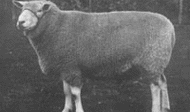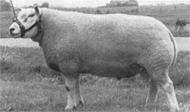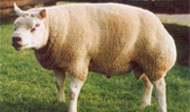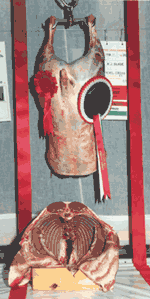Looking for pedigree sheep?
Cliquez ici pour franšais:The origins of the breed
Sheep have been on Texel for a very long time. There are documents dating back to 1477 which prove that there were many sheep on Texel even then. Until 1860 these were mainly the so-called pijlstaarten, a polled, thrifty breed with good wool, but only moderately muscled. About 1860 this stock was crossed first with the Leicester and later with the Lincoln as well. This improved both meatiness and wool quality.
The founding of the Texel Sheep herdbook in North Holland (T.S.N.H. for short) in 1909 brought more structure to the breeding; the crossing stopped and breed characteristics were established. Gradually the Texel sheep, also known as the Texel, developed, with its adaptability and high meat quality.
 |
 |
 |
1907 |
1975 |
present |
The size of the breed
When the herdbook was established, Texels were mainly found in the provinces of North and South Holland, but afterwards they spread to other provinces as well. In other countries, too, the Texel became known for its meat quality, so exports began to England, France, Denmark, Belgium and later America, Australia and New Zealand as well. In recent years they have been exported to Italy, Portugal, Russia, Northern Ireland, Germany and Brazil, among other countries. The breeders represented on this site have a joint population of about 2200 animals.
 The basis
The basisThe starting point for the breeding of Texels is a sheep farm which aims at the most efficient meat production, while retaining a sufficient number of breed characteristics. The Texel can fulfil the following functions:
- Terminal sire
Breeding and selection are aimed at the sale of stud rams for the production of slaugher lambs - Terminal dams
Breeding and selection are aimed at the sale of breeding ewes for the production of slaughter lambs. The sheep may be genetically predisposed to both functions
The Texel is a medium sized sheep, which lambs once a year. Adult ewes usually give birth to and suckle two lambs per lambing. Ewes can already give birth at the age of one. The Texel has a very good slaughter quality. The fat deposition is excellent. The body of a Texel is thick-set, beam shaped and seems massive. The head is distinctive, evenly proportioned and has a straight nasal bone and a wide mouth. Furthermore, a black rhinarium and white hair are desirable. The neck is sufficiently long and well-placed. The trunk is well-muscled, with especially well-developed loins and thighs. The forehand, middle and hind quarters are evenly proportioned. The forehand is broad and deep, with well-placed, reasonably long shoulders and a breastbone which extends sufficiently to the front. The middle is long and broad, with sufficient depth in the ribs and broad, strong loins. The hind quarters are broad, while the croup is long an slightly sloped off. The legs are delicately structured, dry and powerful, correct both when the sheep is walking and standing still. The wool is fine, with a close staple. It does not contain excess fat. The trunk is covered with a white fleece. The head and legs are unwooled, but covered with white hair. The tail is thin and has a good length.
A fully-grown ram weighs approximately 95 kilos and stands 70 centimetres at the withers. A fully-grown ewe weighs approximately 75 kilos and stands 68 centimetres at the withers